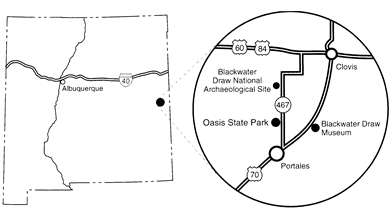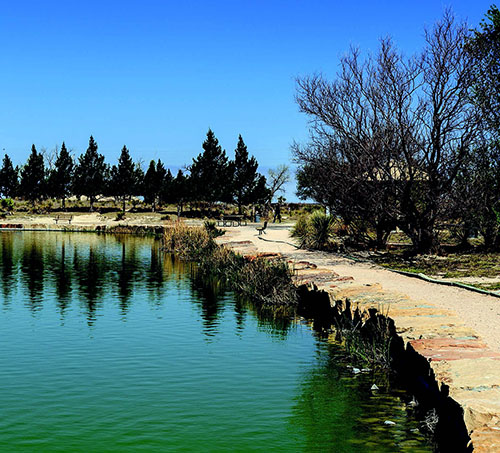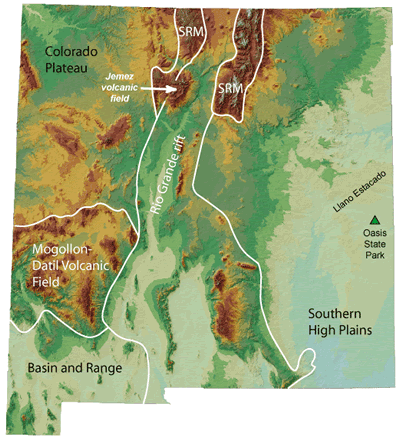
Oasis State Park
Introduction


Peter A. Scholle
Oasis State Park lies 18 miles southwest of Clovis and 7 miles north of Portales via US–60 and NM–467 (Fig. 1). It was established in 1961 to preserve the natural beauty of a true oasis in the sandy desert of the Llano Estacado or “staked plains” of the Great Plains physiographic province. The surrounding area is flat, treeless, featureless, and relatively dry. The summers are hot, the winters are cold, the wind seems to blow constantly. In contrast, the park offers shade trees and a small lake (Fig. 2), as well as conveniences such as water, showers, electric hookups, and dump stations expected of picnic areas and modern campgrounds. Many of the facilities are accessible to people with disabilities. In addition to picnicking and camping, fishing, hiking, and bird watching are popular activities. The pond is stocked with catfish and trout. Trails weave up and down and around the sand dunes; watch carefully for lizards, snakes, and other wildlife that make the sand their home! A ballfield lies near the center of the park and there is a new visitor’s center. The Blackwater Draw Museum is located east of Oasis State Park on US-70, and the Blackwater Draw Archaeological Site is north of the state park (Fig. 1).
Geology
Oasis State Park is in the Portales Valley, an inset in the Llano Estacado. The llano extends from the Pecos River on the west to Palo Duro Canyon in Texas on the east and southward to Hobbs, New Mexico. It covers an area of about 32,000 mi2 (Reeves, 1972, Hawley, 1993; Holliday, 1995). The origin and meaning of Llano Estacado are controversial. Some claim that the name refers to natural stockades created along the rough rim of this plateau that rises 150 ft above the adjacent plains and river valleys. Estacada is Spanish for palisade or fence, and canyons along the rim became famous as pasture for cattle and horses. Other explanations for the term range from the tall native yuccas, resembling stakes at a distance, to tales of Indians and then wagon trains from the east marking their routes across this vast, featureless plateau with stakes (Julyan, 1996).
The llano is formed on the Ogallala Formation. The Ogallala Formation consists of eolian (wind-blown) sand and silt and fluvial (stream or river) and lacustrine (lake) sand, silt, clay, and gravel derived from the Rocky Mountains between middle Miocene and early Pliocene time, about 1–12 million yrs (m.y.) ago (Reeves, 1972; Hawley, 1984, 1993; Gustavson et al., 1991). These surficial deposits were reworked and deposited by water and wind. In many places a caprock of hard, impermeable calcium carbonate (CaCO3), locally called caliche, formed near the surface in arid conditions during the early Pliocene or later. This caprock forms the rim of the Llano Estacado and is approximately 10–40 ft thick in the Clovis–Portales area (Galloway, 1956, 1972). The caprock consists of fractured and permeable deposits of gravel, sand, silt, and clay that are cemented by calcium carbonate (McGrath and Hawley, 1985). It is used locally for crushed and decorative stone. The caprock is a calcrete and is formed primarily by the process of downward percolation of surface waters depositing calcium carbonate in the upper soil horizons in the Ogallala Formation and perhaps, even in the overlying Blackwater Draw Formation and recent eolian deposits (Bachman, 1976; McGrath and Hawley, 1985). Important aquifers (reservoirs of ground water) occur in the Ogallala Formation, and they supply much of the water used for livestock, irrigated farms, and recreation areas such as the state park. Much of this water originally was derived from the Sangre de Cristo Mountains before the Pecos River captured most of the water now migrating from those mountains. The only recharge or new water to the Ogallala aquifer in this area of New Mexico–Texas is from rain along the Llano Estacado. Pumping for irrigation and municipal use is depleting the aquifer faster than it is being recharged.
The rocks underlying the Ogallala Formation are not exposed in the area, but belong to the Chinle Group (formerly known as the Dockum Group) of Triassic age (245–208 m.y.; Lucas, 1993). From wells drilled in the area looking for deeper reservoirs of water and even oil and gas, we know that these older rocks consist of red-brown siltstone, sandstone, and shale. Similar rocks are exposed elsewhere in eastern New Mexico, such as in the Tucumcari–Santa Rosa area.

The Pleistocene Blackwater Draw Formation overlies the Ogallala Formation in parts of Curry and Roosevelt Counties and consists of thin, silty to clayey soils. The Portales Valley is the headwaters for two draws, Blackwater and Yellowhorse (Holliday, 1995), and merges with the Llano Estacado. Lacustrine deposition began about 11,000 yrs ago in the beginning of the Folsom period (Holliday, 1989, 1995). The Blackwater Draw Formation was formed by episodic cycles of eolian deposition during dry periods, followed by subhumid to semiarid conditions forming more-cemented soils. Numerous cycles occurred for at least 1.6 m.y. to form the Blackwater Draw Formation. This unit is as thick as 81 ft and extends from the Pecos River valley eastward to Amarillo and Lubbock, Texas (Holliday, 1989). The grain size of the soils decreases from the southwest (predominantly sand) to the northeast (predominantly silt), indicating that the source was the Pecos River valley (Holliday, 1989). Three ash units occur in the formation and have been dated as 1.61 m.y. (Guaje Pumice), 1.59–1.22 m.y. (Cerro Toledo tephra), and 1.22 m.y. (Tsankawi Pumice). These ash beds were formed by ash erupted and blown by the wind from the Jemez volcanic field in central New Mexico (Fig. 3; Izett et al., 1972; Gardner and Goff, 1996; Spell et al., 1996). The Brazos River flowed through the Portales area earlier and deposited the gravels that localized the pond used by prehistoric man at the Blackwater Draw Archaeological Site (Taylor and Pitt, 1972; Hester, 1972; Holliday, 1995). In the Pleistocene, the Pecos River captured the Brazos River, and the springs were formed. The springs fed the pond at Blackwater Draw Archaeological Site.

Recent sand dunes locally overlie the Blackwater Draw Formation. At the state park, these sand dunes are white because the sand is composed of medium-to fine-grained, white to clear quartz, gypsum, calcite, and feldspar crystals. The constant wind moves the sand, forming new dunes almost daily. Geologists can tell from the shape of the dunes which way the wind is blowing (Fig. 4). Most of the dunes are crescent shaped in plan view because they are formed by constant wind predominantly from one direction across a flat desert floor; these are called barchan dunes. Parabolic dunes, which are also crescent shaped, are locally formed by wind from the opposite direction.
References
- Bachman, G. O., 1976, Cenozoic deposits of southeastern New Mexico and an outline of the history of evaporite dissolution: U. S. Geological Survey, Journal of Research, v. 4, pp. 135–149.
- Galloway, S. E., 1956, Geology and groundwater resources of the Portales Valley area, Roosevelt and Curry Counties, New Mexico: Unpublished MS thesis, University of New Mexico, Albuquerque, 167 pp.
- Galloway, S. E., 1972, Urban geology of Clovis; in Kelley, V. C., and Trauger, F. D. (eds.), East-central New Mexico: New Mexico Geological Society, Guidebook 23, pp. 212–213.
- Gardner, J. N., and Goff, F., 1996, Geology of the northern Valles caldera and Toledo embayment, New Mexico; in Goff, F., Kues, B. S., Rogers, M. A., McFadden, L. D., and Gardner, J. N. (eds.), The Jemez Mountains region: New Mexico Geological Society, Guidebook 47, pp. 225–230.
- Gustavson, T. C., Baumgardner, R. W., Jr., Caron, S. C., Holiday, V. T., Mehnert, H. H., O’Neill, J. M., and Reeves, C. C., Jr., 1991, Quaternary geology of the southern Great Plains and an adjacent segment of the rolling plains; in Morrison, R. B. (ed.,) Quaternary Nonglacial Geology; Conterminous U. S.: Boulder, Colorado, Geological Society of America, Vol. K-2, The Geology of North America, pp. 477–501.
- Hawley, J. W., 1984, The Ogallala Formation in eastern New Mexico: Proceedings of the Ogallala aquifer Symposium II: Texas Tech University, Water Resources Center, pp. 157–176.
- Hawley, J. W., 1993, The Ogallala and Gatuña Formations in southeastern New Mexico region, a progress report; in Love, D. W., Hawley, J. W., Kues, B. S., Adams, J. W., Austin, G. S., and Barker, J. M. (eds.), Carlsbad region: New Mexico Geological Society, Guidebook 44, pp. 261–269.
- Haynes, C. V., Jr., 1995, Geochronology of paleoenvironmental change, Clovis type site, Blackwater Draw, New Mexico: Geoarchaeology, An International Journal, v. 10, no. 5, pp. 317–388.
- Hester, J. J., 1972, Blackwater locality No. 1: Fort Burgwin Research Center, Inc. Southern Methodist University, Ranchos de Taos, New Mexico, 239 pp.
- Holliday, V. T., 1989, The Blackwater Draw Formation (Quaternary): a 1.4-plus-m.y. record of eolian sedimentation and soil formation on the southern High Plains: Geological Society of America, Bulletin, v. 101, pp. 1598–1607.
- Holliday, V. T., 1995, Stratigraphy and paleoenvironments of late Quaternary valley fills on the southern High Plains: Geological Society of America, Memoir 186, 136 pp.
- Izett, G. A., Wilcox, R. E., and Borchart, G. A., 1972, Correlation of a volcanic ash bed in Pleistocene deposits near Mt. Blanco, Texas with the Guaje pumice bed of the Jemez Mountains, New Mexico: Quaternary Research, v. 2, pp. 554–578.
- Julyan, R., 1996, The place names of New Mexico: University of New Mexico Press, Albuquerque, 385 pp.
- Lucas, S. G., 1993, The Chinle Group: revised stratigraphy and biochronology of Upper Triassic nonmarine strata in the western United States; in Morales, M. (ed.), Aspects of Mesozoic geology and paleontology of the Colorado Plateau: Museum of Northern Arizona, Bulletin 59, pp. 27–50.
- McGrath, D. A., and Hawley, J. W., 1985, Calcretes of the Santa Rosa area; in Lucas, S. G., and Zidek, J. (eds.), Santa Rosa–Tucumcari region : New Mexico Geological Society, Guidebook 36, pp. 4–6.
- Reeves, C. C., Jr., 1972, Tertiary–Quaternary stratigraphy and geomorphology of west Texas and southeastern New Mexico; in Kelley, V. C., and Trauger, F. D. (eds.), East-central New Mexico: New Mexico Geological Society, Guidebook 23, pp. 108–117.
- Skinner, B. J., and Porter, S. C., 1987, Physical geology: John Wiley and Sons, New York, New York, 750 pp.
- Spell, T. L., Kyle, P. R., and Baker, J., 1996, Geochronology and geochemistry of the Cerro Toledo Rhyolite; in Goff, F., Kues, B. S., Rogers, M. A., McFadden, L. D., and Gardner, J. N. (eds.), The Jemez Mountains region: New Mexico Geological Society, Guidebook 47, pp. 263–268.
- Taylor, R. G., and Pitt, W. D., 1972, Urban geology of Portales; in Kelley, V. C., and Trauger, F. D. (eds.), East-central New Mexico: New Mexico Geological Society, Guidebook 23, pp. 214–215.
- Young, J. V., 1984, The state parks of New Mexico: University of New Mexico Press, Albuquerque, 160 pp.



